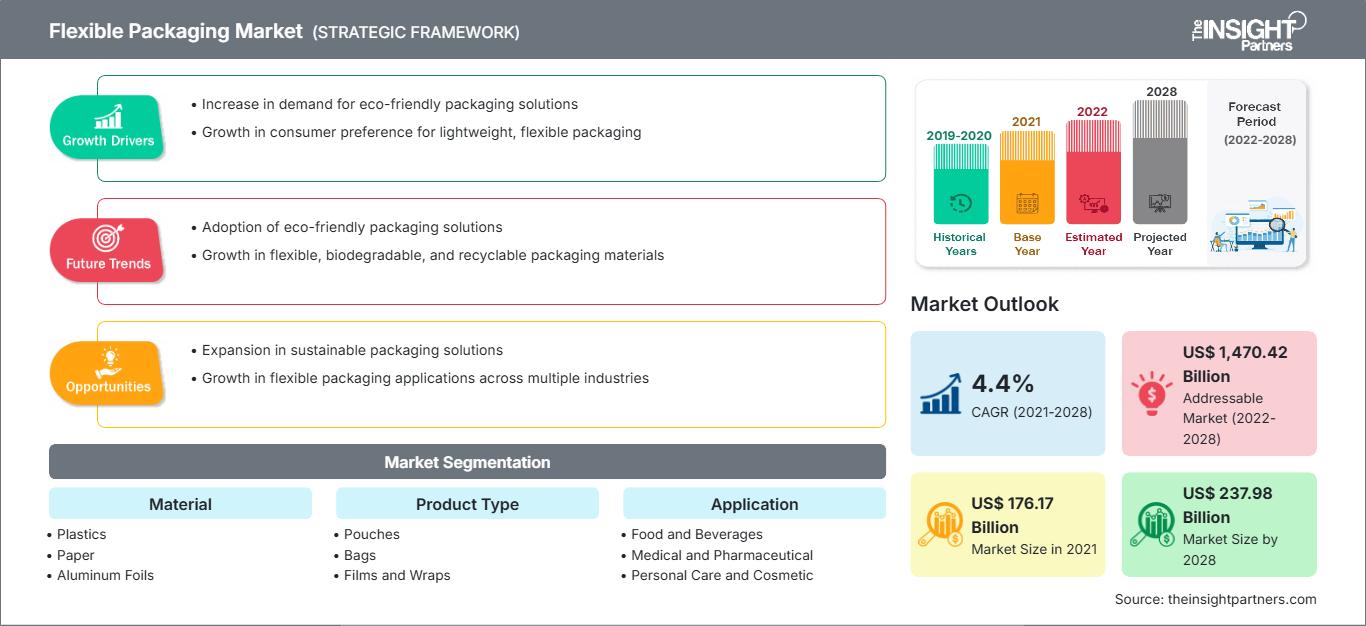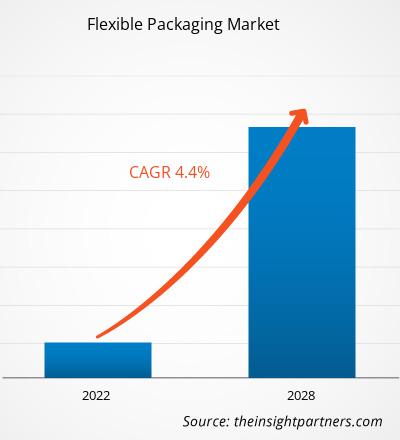Der Markt für flexible Verpackungen soll von 176.173,61 Millionen US-Dollar im Jahr 2021 auf 237.975,67 Millionen US-Dollar im Jahr 2028 anwachsen; von 2021 bis 2028 wird ein durchschnittliches jährliches Wachstum von 4,4 % erwartet.
Flexible Verpackungen umfassen Liner, Beutel, Verschlüsse, Probenpäckchen und Tüten. Sie können aus Film, Kunststoff, Papier, Alufolie usw. bestehen. Sie werden für verschiedene Lebensmittel und Getränke, Konsumgüter, Musik-CDs, Arzneimittel, Computersoftwarepakete und Nutrazeutika verwendet. Die Haltbarkeit flexibler Verpackungen ermöglicht es Herstellern, auffällige und hochwertige individuelle Designs zu drucken, die die Produktsichtbarkeit im Einzelhandel erhöhen.
Im Jahr 2020 hatte der asiatisch-pazifische Raum den größten Umsatzanteil am globalen Markt für flexible Verpackungen. Laut der Asiatisch-Pazifischen Wirtschaftsgemeinschaft ist Australien eines der entwickelten Länder in APAC. Der Lebensmittel- und Die Getränkeindustrie ist Australiens größte Fertigungsindustrie und erwirtschaftet 32 % des gesamten Produktionsumsatzes des Landes. Laut dem Branchenbericht 2019 des Australian Food and Grocery Council hat der Lebensmittel- und Getränkesektor sowie der Lebensmittel- und Frischwarensektor einen Wert von 85,32 Milliarden US-Dollar. Die Branche umfasst 15.000 Unternehmen aller Größen und beschäftigt über 273.000 Mitarbeiter. Die wachsende Lebensmittel- und Getränkeindustrie treibt den Markt für flexible Verpackungen voran.
Passen Sie diesen Bericht Ihren Anforderungen an
Sie erhalten kostenlos Anpassungen an jedem Bericht, einschließlich Teilen dieses Berichts oder einer Analyse auf Länderebene, eines Excel-Datenpakets sowie tolle Angebote und Rabatte für Start-ups und Universitäten.
Markt für flexible Verpackungen: Strategische Einblicke

- Holen Sie sich die wichtigsten Markttrends aus diesem Bericht.Dieses KOSTENLOSE Beispiel umfasst Datenanalysen, die von Markttrends bis hin zu Schätzungen und Prognosen reichen.
Sie erhalten kostenlos Anpassungen an jedem Bericht, einschließlich Teilen dieses Berichts oder einer Analyse auf Länderebene, eines Excel-Datenpakets sowie tolle Angebote und Rabatte für Start-ups und Universitäten.
Markt für flexible Verpackungen: Strategische Einblicke

- Holen Sie sich die wichtigsten Markttrends aus diesem Bericht.Dieses KOSTENLOSE Beispiel umfasst Datenanalysen, die von Markttrends bis hin zu Schätzungen und Prognosen reichen.
Auswirkungen der COVID-19-Pandemie auf den Markt für flexible Verpackungen
Die Schließung von Produktionsstätten, Schwierigkeiten bei der Rohstoffbeschaffung und Logistikbeschränkungen haben sich negativ auf den Markt für flexible Verpackungen ausgewirkt. COVID-19 hat jedoch zu einem massiven Anstieg der Online-Lebensmittellieferungen geführt. Darüber hinaus verzeichnet die Lebensmittel- und Getränkeindustrie einen Anstieg der Nachfrage nach haltbaren Lebensmitteln und Getränken, einschließlich Milchprodukten, da die Verbraucher ihre Vorratskammern auffüllen. Millionen von Haushalten haben begonnen, Lebensmittel online zur Abholung oder Lieferung nach Hause zu kaufen, und viele werden auch nach der Krise weiterhin E-Commerce-Optionen nutzen. Darüber hinaus wird die steigende Nachfrage nach verarbeiteten Lebensmitteln wie Fertiggerichten, die im Allgemeinen hochdichte, hochwertige Verpackungsmaterialien für eine längere Haltbarkeit verwenden, den Bedarf an flexiblen Verpackungen weiter ankurbeln.
MarkteinblickeZunehmender Konsum von verarbeiteten Lebensmitteln und Getränke
Laut dem Bericht von Anu Food Brazil betrug der Gesamtumsatz des brasilianischen Lebensmitteleinzelhandels im Jahr 2019 96 Milliarden US-Dollar. Die brasilianische Lebensmittel- und Getränkeindustrie erzielte 2019 ein Wachstum von 6,7 % und 2020 von 12,8 %. Der Markt für Tiefkühlkost floriert in Brasilien aufgrund der Vergrößerung der Mittelschicht, der steigenden Kaufkraft und der Zunahme der Zahl der Vollzeitbeschäftigten. Daher treibt die zunehmende Vorliebe der Verbraucher für Fertiggerichte den Markt für flexible Verpackungen an.
Einblicke in die Materialbranche
Basierend auf dem Material ist der globale Markt für flexible Verpackungen in Kunststoffe, Papier, Aluminiumfolien und Sonstiges unterteilt. Das Segment Kunststoffe hatte 2020 den größten Anteil am globalen Markt für flexible Verpackungen. Flexible Kunststoffverpackungen umfassen verschiedene Arten von Kunststoffmaterialien, die für die Verpackung unterschiedlicher Produkte verwendet werden. Die Art des Verpackungsmaterials hängt von der Anwendung und der Art des zu verpackenden Produkts ab. In der Regel werden Kunststoffe wie Polyethylen, Polypropylen, Polystyrol und Polyvinylchlorid für flexible Kunststoffverpackungen verwendet. Flexible Verpackungen gelten als die bequemste und wirtschaftlichste Möglichkeit, Lebensmittel, Getränke, Pharmaprodukte und verschiedene Verbrauchsgüter aufzubewahren, zu verpacken und zu vertreiben.
Zu den wichtigsten Akteuren auf dem globalen Markt für flexible Verpackungen gehören Amcor plc, Huhtamaki, Mondi, Berry Global Inc., Sealed Air, Sonoco Products Company, Coveris, Constantia Flexibles, Flexpak Services und Transcontinental Inc. Die Akteure auf dem Markt konzentrieren sich stark auf die Entwicklung hochwertiger und innovativer Produktangebote, um die Anforderungen der Kunden zu erfüllen.
Flexible VerpackungenRegionale Einblicke in den Markt für flexible Verpackungen
Die Analysten von The Insight Partners haben die regionalen Trends und Faktoren, die den Markt für flexible Verpackungen im Prognosezeitraum beeinflussen, ausführlich erläutert. In diesem Abschnitt werden auch die Marktsegmente und die geografische Lage in Nordamerika, Europa, dem asiatisch-pazifischen Raum, dem Nahen Osten und Afrika sowie Süd- und Mittelamerika erörtert.
Umfang des Marktberichts über flexible Verpackungen
| Berichtsattribut | Einzelheiten |
|---|---|
| Marktgröße in 2021 | US$ 176.17 Billion |
| Marktgröße nach 2028 | US$ 237.98 Billion |
| Globale CAGR (2021 - 2028) | 4.4% |
| Historische Daten | 2019-2020 |
| Prognosezeitraum | 2022-2028 |
| Abgedeckte Segmente |
By Material
|
| Abgedeckte Regionen und Länder | Nordamerika
|
| Marktführer und wichtige Unternehmensprofile |
|
Dichte der Marktteilnehmer für flexible Verpackungen: Verständnis ihrer Auswirkungen auf die Geschäftsdynamik
Der Markt für flexible Verpackungen wächst rasant. Die steigende Nachfrage der Endverbraucher ist auf Faktoren wie veränderte Verbraucherpräferenzen, technologische Fortschritte und ein stärkeres Bewusstsein für die Produktvorteile zurückzuführen. Mit der steigenden Nachfrage erweitern Unternehmen ihr Angebot, entwickeln Innovationen, um den Bedürfnissen der Verbraucher gerecht zu werden, und nutzen neue Trends, was das Marktwachstum weiter ankurbelt.

- Holen Sie sich die Markt für flexible Verpackungen Übersicht der wichtigsten Akteure
Bericht-Spotlights
- Progressive Trends in der flexiblen Verpackungsindustrie, um Akteuren bei der Entwicklung effektiver langfristiger Strategien zu helfen
- Geschäftswachstumsstrategien der Marktteilnehmer in Industrie- und Entwicklungsländern
- Quantitative Analyse des Marktes für flexible Verpackungen von 2019 bis 2028
- Schätzung der weltweiten Nachfrage nach flexiblen Verpackungen
- Porters Fünf-Kräfte-Analyse zur Veranschaulichung der Wirksamkeit von Käufern und Lieferanten in der Branche
- Jüngste Entwicklungen zum Verständnis des Wettbewerbsmarktszenarios
- Markttrends und -aussichten sowie Faktoren, die das Wachstum des Marktes für flexible Verpackungen vorantreiben und hemmen
- Unterstützung im Entscheidungsprozess durch Hervorhebung von Marktstrategien, die das kommerzielle Interesse untermauern und zum Marktwachstum führen
- Die Größe des Marktes für flexible Verpackungen an verschiedenen Knotenpunkten
- Detaillierte Übersicht und Segmentierung des Marktes sowie die Branchendynamik
- Größe des flexiblen Verpackungsmarkt in verschiedenen Regionen mit vielversprechenden Wachstumschancen
- Historische Analyse (2 Jahre), Basisjahr, Prognose (7 Jahre) mit CAGR
- PEST- und SWOT-Analyse
- Marktgröße Wert/Volumen – Global, Regional, Land
- Branchen- und Wettbewerbslandschaft
- Excel-Datensatz
Aktuelle Berichte
Erfahrungsberichte
Grund zum Kauf
- Fundierte Entscheidungsfindung
- Marktdynamik verstehen
- Wettbewerbsanalyse
- Kundeneinblicke
- Marktprognosen
- Risikominimierung
- Strategische Planung
- Investitionsbegründung
- Identifizierung neuer Märkte
- Verbesserung von Marketingstrategien
- Steigerung der Betriebseffizienz
- Anpassung an regulatorische Trends




















 Kostenlose Probe anfordern für - Markt für flexible Verpackungen
Kostenlose Probe anfordern für - Markt für flexible Verpackungen